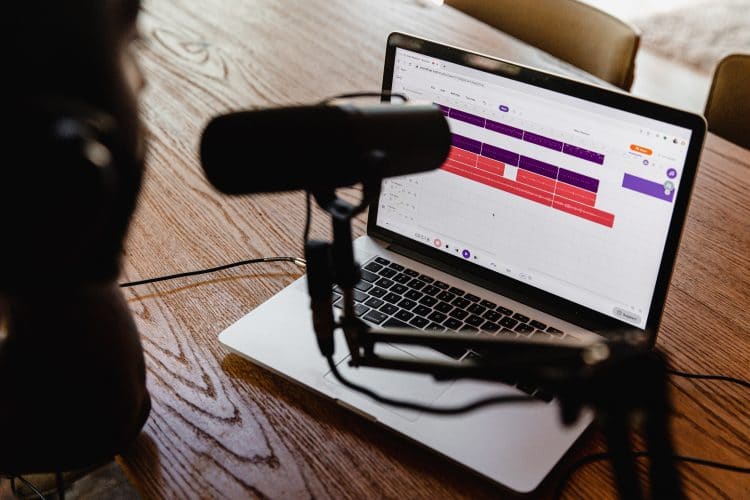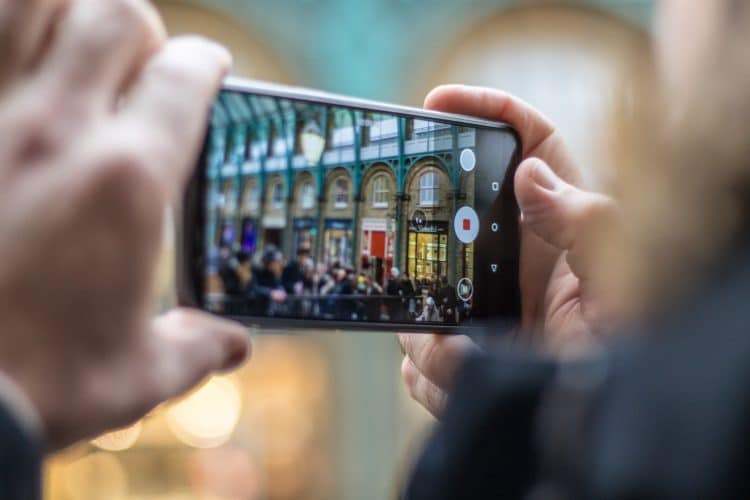The power of video content is undeniable. It helps get your message across quickly, entertainingly and allows your personality to shine through. Visitors are drawn into video more easily than written text and a short video could be a great introduction to you, your brand or your business. Research confirms the value of video, with Search Engine Report suggesting video content makes up around 65% of all search results.
Google loves video content and as more creators and businesspeople look to use this fact, accessibility and disability friendly video becomes ever more important. Accessible video is what the search engines really want to see, and creating it isn’t that difficult, even if all you’re working from is your cell phone and a few additional bits of kit. Pairing your phone with a decent microphone, tripod and some useful apps and software can lead to much better quality video, accessible to a wider audience.

Why Does Google rate Video Content so Highly?
Google’s theory is based on the level of input and work involved in creating video. As video takes longer to produce and get right, it is ranked more highly in their search engine results. It’s also worth remembering that sites which include video usually see visitors sticking around for longer as they take time to watch the video content, whereas they may just skim through text.
Making videos accessible also further extends the time someone may spend on a website. LiveClicker found pages with transcripts can earn 16% more revenue than those that have just video and it shows taking time to create content which meets the needs of as many users as possible has the best chance of ranking highly. Many people benefit from transcription and written content to support video so it’s beneficial to offer it wherever you can.
The amount of time users spend on a website directly impacts their search ranking position and more than this, who wouldn’t want their content to be accessible and enjoyed by as wide an audience as possible?
How to make your Video Content Accessible

Meeting your video accessibility goals requires more time and attention but the results are definitely worth it. The W3C Web Accessibility Initiative (WAI) website has comprehensive guidelines for making audio-visual content accessible and this can be applied to any kind of content, from a simple personal blog to a popular podcast to product release videos and advertisements. Here we’re looking over some key tips for creating content which delivers your goals and also ensures it is as accessible as possible for people with disabilities and different needs.
1. Accessibility from the Start
Trying to retroactively add in accessible factors is not the path to success. All content should be considered with an accessible approach in mind. Text should use high contrast colours and remain on screen for long enough for it to be read by accessibility devices as well as users themselves.
2. Use an Accessible Video Player
Many popular video players are inaccessible to some groups of disabled people. Many video players incorporate keyboard traps which means the keyboard focus gets trapped within the video and only closing the browser will fix the issue. This means keyboard users cannot access the content at all. Other video players have no support for audio descriptions or captions which are vital for people with hearing and visual impairments.
3. Block Autoplay
No video content should play unless the visitor to your site wants it to play. This can be annoying for people without disabilities and can make your site inaccessible to people using certain software and apps. People using screen readers due to visual impairment for example, can find their reading software is confused and can be drowned out or blocked by the automatic video.
4. Provide Transcripts and Captions
A transcript is more than just a script of the speech in a video. It should contain descriptions of any actions or information on-screen. Transcripts should be positioned directly after the video or linked to immediately after it. There are also apps and software which offer interactive transcript production, which can make it easier to capture elements of the text if visitors want to cut, paste and keep hold of the content for any reason.
Captions are a text version of the speech and sound the video displays. They usually appear at the bottom of the video and can be toggled on and off by the user if they want to see them or not. They can be useful for viewers with hearing impairments. Captions are not the same as subtitles and will incorporate elements aside from the speech, such as doors opening and closing or music playing, as a caption would read “music playing” or specify the music. YouTube can provide automatic captions, but they are not recommended as they can’t be monitored as closely as something you create yourself.
5. Use Audio Descriptions
An audio description is a spoken audio track which plays alongside the video and it ensures people with vision impairments can understand what is happening in the video. All visual information should be available through the audio description and it may mean you need to pre-record some information about the setting and what is about to happen before the video begins, so viewers have an understanding of what is happening in advance of the spoken video content beginning. Extended audio descriptions can also be made available.
Keeping these points in mind before you even set up your space for recording video is important so you are ready to create content for all visitors without having to go back and make significant changes. It’s also important to remember that the majority of changes you make for a more accessible website appeal to a wider audience, not just people with disabilities. Including captions and transcripts can support people with English as an additional language who may benefit from reading the content as well as hearing it.

Tips for Better Audio-Visual Content Creation
Now you’ve got a good understanding of how to ensure your video content is accessible, you can get a look at creating your videos and related content. As mentioned, it is completely possible to create high quality video content without huge investment in new technology and equipment. Great video is often created from a tablet or cell phone with additional kit to enhance the in-built features of your device. Keep these tips in mind to ensure your cell phone video content is of the best quality and appears professional.
Get your Tech Setup Properly
There really is no need to invest in hugely expensive recording equipment if you’re planning on creating the occasional video or running a podcast or something similar. Many YouTube vlogging stars use nothing but their cell phones.
To begin, we recommend getting a decent tripod to ensure your device is held steady. While you can hold your cell or tablet, no one has perfectly steady hands and this will impact on the quality of the video and with your hands-free you can do more too. Many vloggers rely on tripods or selfie sticks to ensure they’re able to create the content they’re aiming for and it can give you more freedom with your video content.
Secondly, never underestimate the importance of quality audio for video content. Many creators make this mistake and forget to optimise or consider the quality of their audio altogether. Good quality audio is essential for meaningful and memorable video content. Investing in a quality Bluetooth microphone or other external compatible microphone is the best way to ensure your video content doesn’t disappoint when it comes to sound.
Get your Settings Right

Before you begin to record video on your cell, ensure it is properly set up for the process. Video resolution is one of the key features you’ll want to check. Most video creators use the largest video resolution their device will allow, which is usually 4K. Other resolutions are still suitable, but most creators opt for 4K.
You should also check the frame rate and see how many individual frames per second your video can record at. The higher the number you choose the smoother the video will look. Most videos are shot at 29.97 fps. Some videographers opt for higher fps but it depends on many factors and you can experiment with the different options before making your final decision.
Never Forget Lighting
Everyone considering creating video content for the first time will come across advice about lighting. Good lighting is critical to any video, especially when you’re using a cell phone or tablet. Try to shoot videos in brightly lit areas as much as possible and this will help cut out annoying shadows or patches of grainy footage in your work. You should also avoid pointing the camera directly at a light source as this will result in overexposure. Many phones and apps offer backlighting or white balance settings to help counteract any issues that come from lack of (or excess of) lighting.
Map and Plan the Full Video
Creating a video should be a process you plan and organize in as much depth as any other element of your content strategy. Map out your plan for the video, from beginning to middle to end, and don’t get lost in a maze of ideas without a logical journey from start to finish. You should also take time to update all necessary tags, categories, and additional SEO elements of your video content, ensuring it is positioned to succeed when put on your website and shared online. The more time you spend on planning and having a good sense of organization and ideal outcome for your video content, the better it will be.
Enhance your Videos with Specialized Apps and Software
Your cell phone will obviously have a built-in camera app, but there are other apps and software programs out there which can enhance the quality of your video. There are many specially designed third-party apps which focus on the development of video content including the all-important editing phase. Investing in an app or two can really enhance the quality of the video you can produce. No video is perfect on first-shoot so remember the editing process should be something you take considerable time over before releasing the final product.
Delivering High Quality Video for Everyone

Video content has become one of the most powerful tools in the marketer’s arsenal. It lets you get your message across quickly and effectively and is one of the most straightforward ways of injecting personality into your content. Visitors are naturally drawn to video and it can provide answers much more quickly than reading through text or can be a valuable complement to the text provided.
As well as visitors loving video content, Google does too, and more creators and businesspeople are becoming aware of this fact. As video grows in popularity and everyone is clamoring to create their own unique and eye-catching content, making accessibility a priority really does matter. Disability friendly content welcomes a wider spectrum of society, expands your audience, and ticks additional boxes in those secret search engine algorithms.
As we’ve shown getting started with quality, professional-standard video content doesn’t require anything more than a reliable cell phone or tablet, a quality external or wireless microphone and additional equipment to keep the camera as steady as possible. Beyond this it’s up to you how you expand your video creation and editing kit, with the essentials in place you won’t be disappointed with the quality you can offer.
